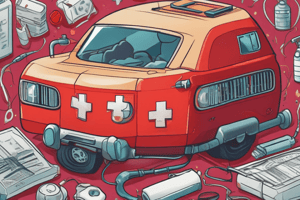Podcast
Questions and Answers
First aid is a long term treatment administered by medical professionals to stabilize a patient.
First aid is a long term treatment administered by medical professionals to stabilize a patient.
False (B)
Providing first aid always requires specialized medical training to be effective.
Providing first aid always requires specialized medical training to be effective.
False (B)
When encountering an accident scene, the first priority should be attending to the injured person, regardless of potential hazards.
When encountering an accident scene, the first priority should be attending to the injured person, regardless of potential hazards.
False (B)
It is generally safe to move an injured person to a more comfortable location while waiting for emergency services.
It is generally safe to move an injured person to a more comfortable location while waiting for emergency services.
When calling 911, providing the exact street address of the emergency is essential for a quick response.
When calling 911, providing the exact street address of the emergency is essential for a quick response.
During a 911 call, it is crucial to hang up immediately after providing basic information to free the line for other calls.
During a 911 call, it is crucial to hang up immediately after providing basic information to free the line for other calls.
The primary aim of first aid is to offer definitive treatment that will completely resolve the injury or illness.
The primary aim of first aid is to offer definitive treatment that will completely resolve the injury or illness.
If a person is actively bleeding from a wound, applying firm pressure to the wound is an appropriate first aid measure.
If a person is actively bleeding from a wound, applying firm pressure to the wound is an appropriate first aid measure.
In a medical emergency, the 911 operator can only dispatch emergency services and cannot provide instructions on how to administer aid.
In a medical emergency, the 911 operator can only dispatch emergency services and cannot provide instructions on how to administer aid.
Your safety at the scene of an accident is less important than immediately helping the injured person.
Your safety at the scene of an accident is less important than immediately helping the injured person.
Flashcards
First Aid
First Aid
Medical attention given to someone injured or ill until medical help arrives, aiming to prevent death or worsening of the injury.
Assess the Scene
Assess the Scene
To evaluate the safety of the surroundings before approaching to give aid.
Call 911
Call 911
Contact emergency services to provide critical details about the situation and location.
Do Not Move Injured Person
Do Not Move Injured Person
Signup and view all the flashcards
Control Bleeding
Control Bleeding
Signup and view all the flashcards
911 Information
911 Information
Signup and view all the flashcards
911 Guidance
911 Guidance
Signup and view all the flashcards
Study Notes
- First aid is medical attention given to someone who is injured or ill until medical help arrives.
- It often involves a one-time or short-term treatment.
- The main goal is to prevent death or the worsening of a serious injury.
- Knowing how to respond properly to accidents or medical emergencies can save lives.
Providing Aid
- In many cases, specialized training is not needed to provide aid.
- Contacting 911 can be crucial in a life-or-death situation.
- A 911 operator can guide you through the necessary steps to help the injured or ill person.
Steps to Take
- Stay calm and assess the situation.
- Ensure your own safety first.
- If the person is seriously injured, unconscious, or in medical distress, call 911 immediately.
- Avoid moving an injured person, especially if there's a suspected head, neck, or back injury, unless they are in further danger.
- Incorrectly moving an injured person can lead to further injuries or paralysis.
- If a person is bleeding, apply gentle pressure to the wound until help arrives.
Calling 911
- The location of the emergency (including the street address) is needed.
- The phone number from which you are calling is needed.
- Describe the nature of the emergency.
- Describe the injuries or symptoms of the person with the emergency.
- The call-taker's questions are important for providing adequate and quick assistance.
- Follow any instructions from the call-taker.
- Many 911 centers can provide aid until help arrives, such as instructions for assisting someone who is choking or needs first aid or CPR.
- Do not hang up until the operator instructs you to do so.
Studying That Suits You
Use AI to generate personalized quizzes and flashcards to suit your learning preferences.



